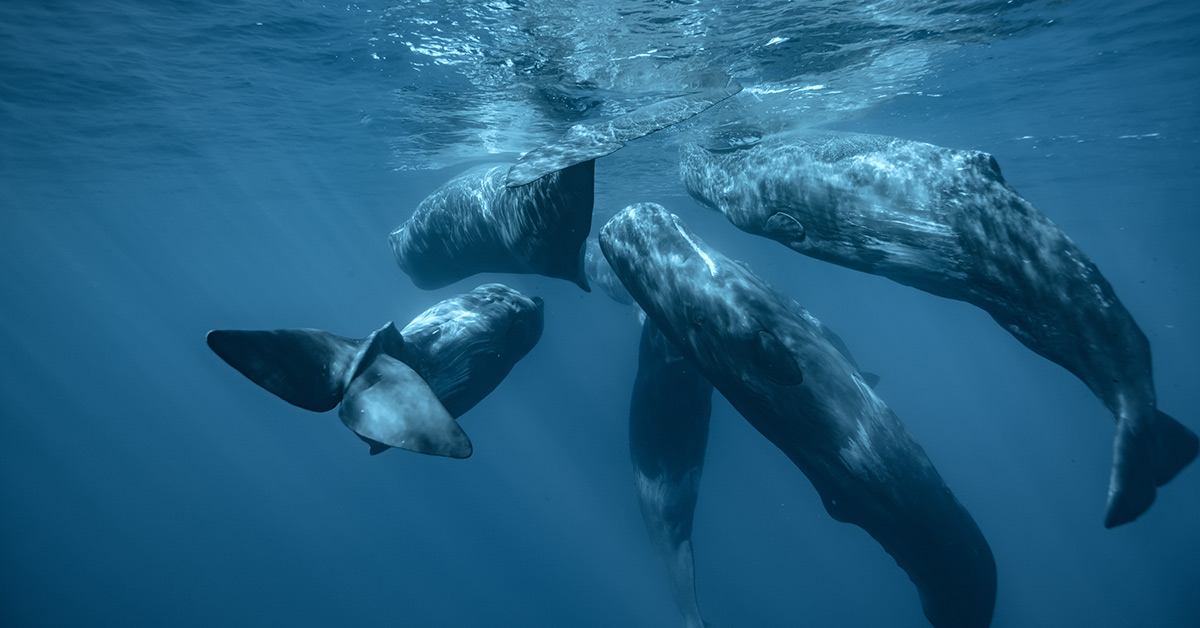Humans, dogs, cats, and many other mammals sleep in similar ways. We lay down, close our eyes, and drift off into dreamland. Aquatic animals, however, can’t just lay down on the ocean floor, so how do they rest? In a rare photo of sleeping whales, a photographer revealed how these massive cetaceans get some shut-eye, and it is a sight to behold.
Sleeping Whales
Photographer Franco Banfi was freediving in the Caribbean Sea when he captured an image of six sperm whales napping. They were grouped together, suspended in the water with their tails down, completely silent. The whales were floating there at a depth of about 65 feet (twenty meters) [1].
Less than two weeks later, french photographer and filmmaker Stephane Granzotto captured whales exhibiting similar behavior while diving in the Mediterranean [2].

Scientists first documented this unusual sleeping strategy in 2008. They published a study in the journal Current Biology in which they measured the underwater activity of 59 sperm whales worldwide. They did so through the use of data-logging tags, which they suction-cupped to the whales for a total of 569.2 hours.
The researchers discovered that whales spend about seven percent of their day sleeping, in bouts of about ten to fifteen minutes at a time. This makes them one of the world’s least sleep-dependent animals. Their study also confirmed that the stereotypical sleeping fashion for these animals worldwide is to drift in a vertical position, as the photographs suggested [3].
Read: This Man Was Only Filming Seagulls, but He Suddenly Captures an Incredible Once-In-A Lifetime Scene

Sleeping Whales in Captivity
Scientists have previously studied sleeping patterns in whales in captivity. They did this using an electroencephalogram (EEG), which monitors brain activity, or by observing eye movements. This, however, is not feasible for whales in the wild.
So how exactly do whales sleep? Let’s compare them to humans:
Humans are able to sleep for long periods of time because we are passive breathers. This means that we are able to breathe automatically, and we don’t have to worry that we’re going to stop breathing once we fall asleep.

By contrast, whales have to “think” about every breath they take. For this reason, they fall into unihemispheric slow-wave sleep. This, essentially, means they sleep with half of their brain. Scientists have observed this in captive whales, and they believe that this could do more than just help them continue to breathe. It may also help sleeping whales avoid predators, maintain social contact with each other, or continue swimming [2,4].
This could also be why they sleep for such short amounts of time. It also explains why different cetaceans (aka marine mammals) sleep for such widely variable amounts of time. For example, researchers have observed humpback whales resting on the surface of the water for up to thirty minutes, Dolphins, on the other hand, sleep at night for a couple of hours. In fact, bottlenose dolphins appear to spend about 33.4 percent of their day sleeping [4].
Read: Astonishing Moment Humpback Whale Saved Woman From A Shark Attack
Do Whales in the Wild Sleep the Same Way?
In short, the researchers aren’t sure. While sailing in a boat off the coast of Chile, the whales did not wake when the vessel was approaching. In fact, they did not come out of their slumber until the boat inadvertently bumped into them. At that point, they startled awake and scattered.
According to the researchers, this suggests that, unlike their captive counterparts, whales in the wild may enter full sleep [3].
Upon further observation, they found that the sperm whales had a strategy for entering into their sleep state. First, they dove head-down to a depth that is several times deeper than the length of their bodies. Then, they passively turned their heads up and drifted toward the surface [1].
The researchers noted that further study of whales’ sleeping patterns will require better procedures for measuring eye movements and other physiological variables for out-of-captivity animals.
For now, we must let sleeping whales lie.
Keep Reading: Authorities Seize Whale Poop Worth $1 Million in Sting Operation
Sources
- “‘Tail-Standing’ Sperm Whales Snooze in Stunning Photo.” Live Science. Mindy Weisberger. July 24, 2017.
- “Why These Whales Are ‘Standing’ In the Ocean.” National Geographic. Sarah Gibbens. August 5, 2017.
- “Stereotypical resting behavior of the sperm whale.” Cell. Patrick J. O. Miller, et al. 2007
- “Sleeping giants — when whales nap.” DW

